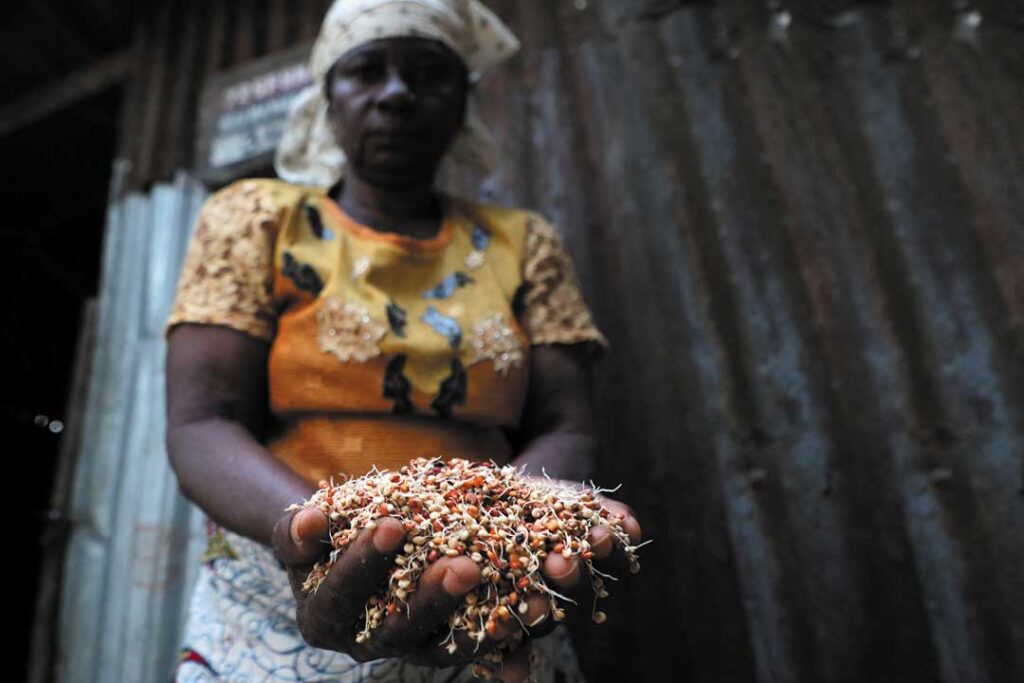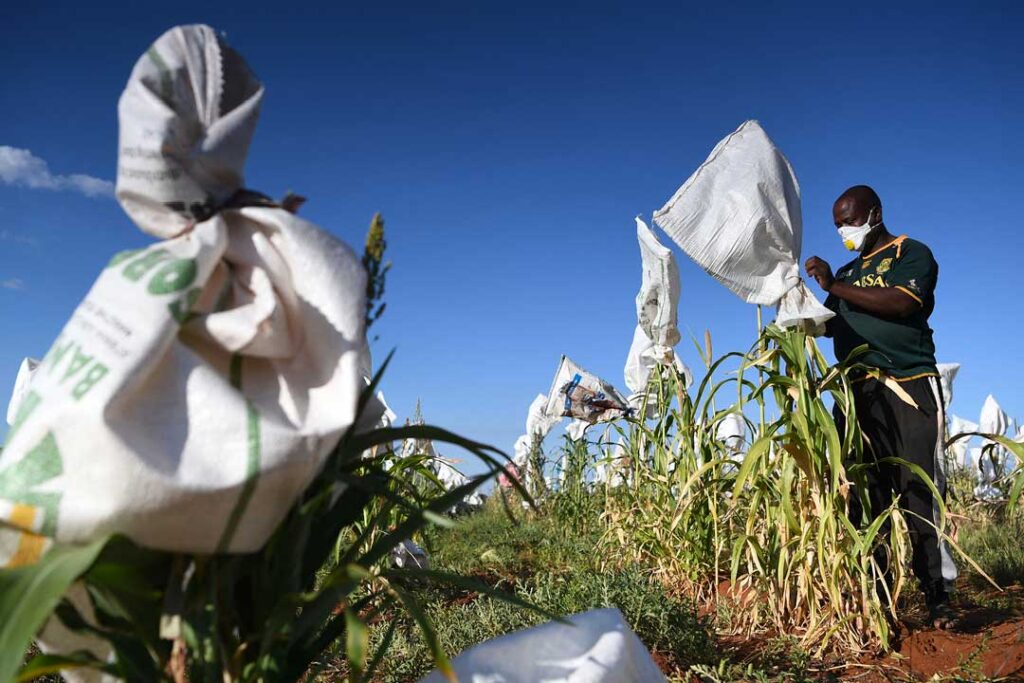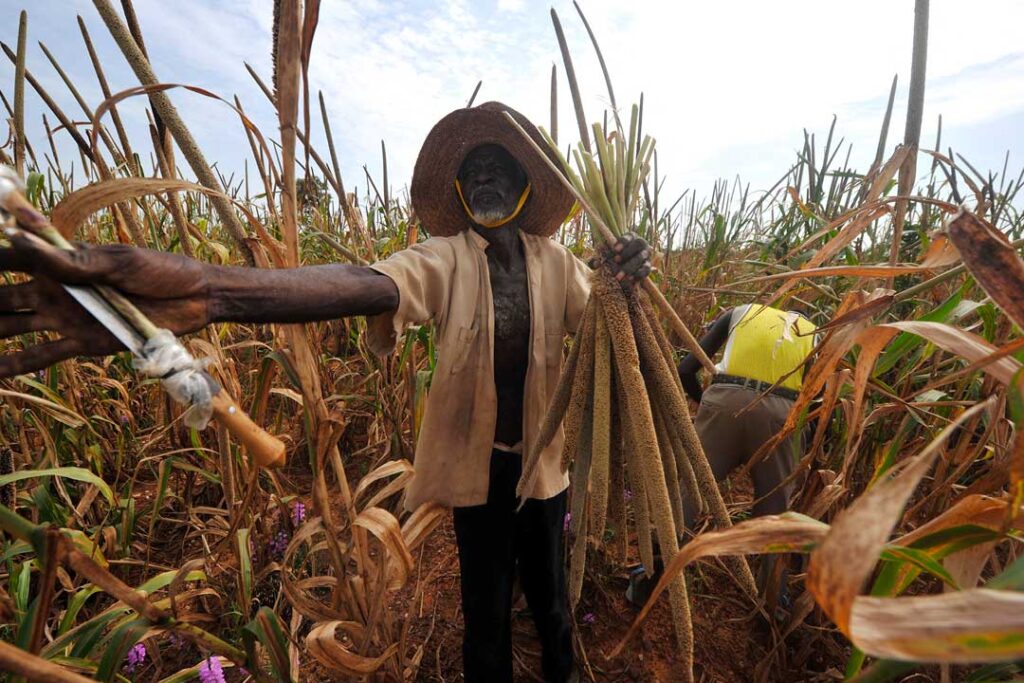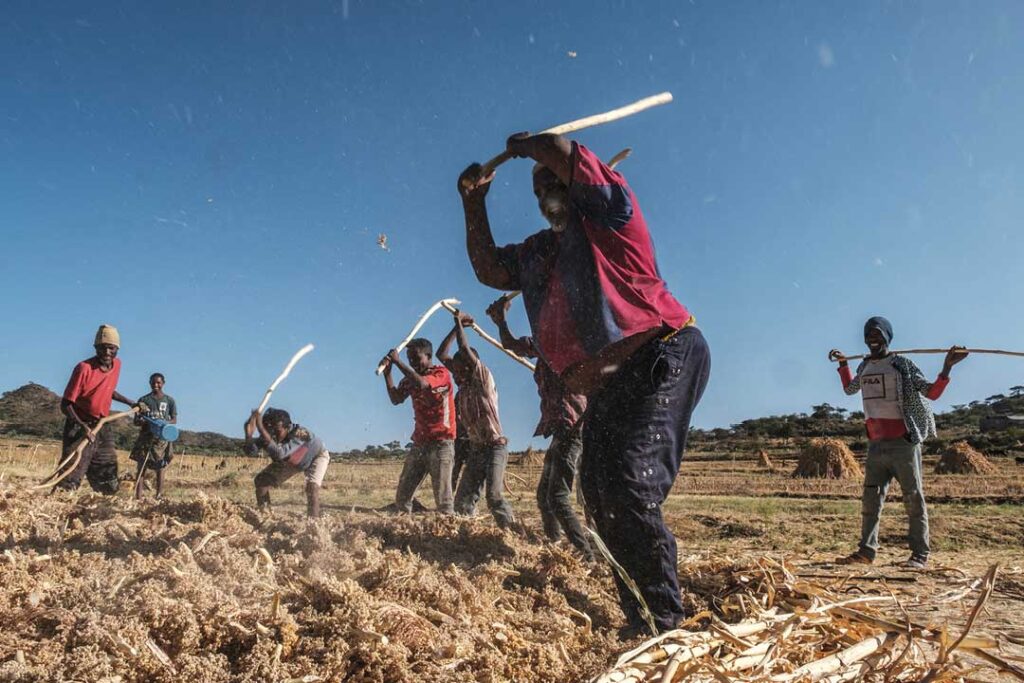Many African countries, particularly those in West, central, and East Africa, are being negatively impacted by anthropogenic (human-induced) climate change. The continent is climatically diverse, both within and between countries, but as the frequency and/or severity of extreme weather events increases, the temperatures rise and rainfall patterns shift, agricultural stress is escalating almost everywhere. These issues are made more difficult by the continent’s and the world’s violent conflicts, rapid population growth, urbanisation, post-pandemic economic vulnerability, and high food import dependency (more than 30% for cereals, according to United Nations data).
The Food and Agriculture Organisation (FAO) definition of food security calls for all people, at all times, to have “sufficient, safe and nutritious food that meets their dietary needs and food preferences.”

The failure to meet this standard is widespread; in 2022, FAO statistics estimated that 20 million Africans were facing hunger. In the Horn of Africa, UNICEF 2023 data reports that seven million children under five are malnourished and in urgent need of nutrition support. There is a critical need to provide not only more food but also nutritionally better, culturally appropriate food while simultaneously supporting climate crisis adaptation and mitigation strategies.
Time is of the essence. Spatial models predicting the impact of climate change on agriculture in sub-Saharan Africa out to 2070 indicate that in the locations where the region’s major staples of maize, rice, cassava, and yams are presently grown, 10% of these areas will alter so radically that none of these crops will be able to survive. Of these, only yams are indigenous to Africa.
It was not ever thus. Historically, African agriculture had a wide range of indigenous and/or traditional (i.e., native to a region or introduced so long ago that they have evolved unique, regionally specific traits) cereals, leafy greens, pulses, roots, tubers, fruits, seeds and nuts that were once the basis for many and varied nutritious foods.
While Africans have traded and incorporated non-native ingredients into their culinary cultures since time immemorial, a combination of the post-15th century Columbian Exchange (between the Americas and Eurasia), colonisation and cash cropping resulted in a widespread transfer of food plants that displaced many traditional species. Such is the extent of the displacement that they are now commonly referred to as neglected and underutilised crop species (NUCS).

Neglected and underutilised, but not extinct. Many continue to exist at the periphery of commercial agriculture, predominantly grown on a small scale and sold at informal markets. Income derived from such sales not only makes a significant contribution to livelihoods but also plays a part in cultural heritage and spirituality across the continent.
As the climate becomes ever more inhospitable, the adapted strengths of NUCS become increasingly apparent. Africa is geologically old and, even prior to climate change, was characterised by degraded soils and irregular rainfall. While no plant can withstand drought indefinitely, many of the NUCS are waterwise, tolerating regionally specific pests and poor soils. Returning to the spatial model described above, whereas 10% of regions will no longer be able to sustain exotics, native crops will still be able to survive in 95% of all current farmlands.
The nutritional content is also advantageous. Several studies have shown indigenous fruits to be higher in Vitamins A and C, while leafy greens are often richer in iron, folate, and zinc. African ancient grains and pulses contain significant proteins and micronutrients. Furthermore, the genetic diversity of NUCS provides a pool of traits for plant breeding programmes that will become increasingly valuable as the climate changes. Biodiversity is also vital for the performance of ecosystem services to improve water quality, maintain soil health and pollinate crops that agriculture depends upon.
That these NUCS are nutritionally advantageous, biologically diverse, adapted to the environment and of socio-spiritual value to many people is indisputable, but if they are to play a significant part in alleviating food insecurity for rapidly increasing, urbanising populations, production must be significantly scaled up.
| Staple | Production | Imports | |
| Maize | 98 399 383 | 17 554 747 | |
| Rice | 37 188 989 | 30 950 668 | |
| Wheat | 29 219 448 | 44 919 732 | |
| Sorghum | 26 280 475 | 709 049 | |
| Millet | 12 105 492 | 68 605 | |
| Fonio | 664 429 | 59 | |
Table 1: Production and imports of selected staples for 2021 (tons)
Table 1 shows that sorghum, millet and fonio make up 20% of staples grown on the continent, but when imports are included, this share falls to 13%, indicating that their contribution is limited. For NUCS to reach their potential, there are a number of obstacles that need to be cleared.
Farmers need access to good seeds if they are to be persuaded to diversify production away from non-native staples. Crop scientists spent more than a century creating high-yield maize, rice and wheat varieties. Nothing like the same effort has gone into improving indigenous/traditional plants, and many countries have no formal seed supply systems, meaning farmers use seeds from one planting season to the next without improvement.
But this situation is beginning to change. At the African Centre for Crop Improvement in Pietermaritzburg, in the province of KwaZulu-Natal, South African seed scientists are working to improve strains of teff, sorghum, cassava and other NUCS. Participatory research with smallholder farmers, drawing on indigenous knowledge, is also underway in Kenya, Tanzania, Benin and Mali to evaluate new varieties, optimise methods to diversify cropping systems and streamline distribution. Policy pertaining to the protection, respect and reward of indigenous knowledge, including agricultural techniques and seed saving, is being drawn up in line with the African Union’s Continental Strategy for Geographic Indications (GIs) 2018–2023.
Farmers contemplating a switch also need assurances that there will be buyers to take and process their crops. These buyers must be able to sell through distribution channels that can take the produce to the consumer. Every link in the chain has to be sufficiently profitable to support those involved. Only then can a farmer justify allocating scarce resources to previously NUCS.

There are indications that NUCS can be profitable and even exportable. New York-based, Senegalese-born chef Pierre Thiam has been central to the promotion of fonio (a West African ancient grain, millet variety) outside of West Africa. His company, Yolele Foods, sells fair trade fonio in Europe and the United States to mitigate against the risk of the superfood curse that has seen previous indigenous ingredients (quinoa, for example) become Western food fashions to the detriment of the communities from whence they come. Thiam currently works with 1,400 women-run fonio growing and processing cooperatives in rural Senegal and is set to expand operations into north and central Mali in early 2024.
“Fonio has the potential to transform the economic landscape of rural West Africa, that’s what drives us at Yolele,” Thiam told Africa in Fact. “We think that the combination of a fair-trade export market and a beneficial, commercial-scale supply chain will provide life-changing results for smallholder farmers while promoting biodiverse, regenerative, and resilient food systems.”
International customers are increasingly asking for African ingredients, but at home, consumer resistance runs high. More than a century of explicit and subliminal messaging around the sophistication of foreign crops has created negative perceptions, equating indigenous ingredients with poverty food. The isiZulu insult: “uyadla imbuia ngothi”, which can be translated as “you are so poor you are eating amaranth again”, is one of many such slurs uttered all across Africa.
Challenging and changing negative perceptions is essential if NUCS are to take their rightful place within African food systems. But there are some signs of social change. The New African Cuisine movement is part of a chef-led process of claiming space for traditional tastes and rebranding the continent’s original ingredients as part of a contemporary, regionally relevant culinary genre. At the Ìtàn Test Kitchen in Lagos, Nigeria, Chef Michael Elégbèdé told Africa in Fact: “I incorporate a personal touch and locally sourced indigenous ingredients with both ancient and modern culinary methods; our restaurant is a fine-dining establishment that will bring Nigerian cuisine [the recognition] it has never seen before.” While Elégbèdé’s restaurant is expensive fine dining fare, media exposure means that its ability to change hearts and minds is much wider than the small pool of those who can afford to eat his work. The chef also coordinates the Abori Network, an online marketplace for Nigerian heritage food suppliers.

One of the ways such crops can be mainstreamed on an increasingly urbanised continent is to make these ancient ingredients user-friendly and quick to cook for time-poor, fuel-poor urban lives. At the University of Johannesburg’s Food Evolution Research Laboratory food scientists are working to develop premixes and other instant products.
Government policy frameworks, regulations, extension services, market support and finance have an important role to play in translating academic theory into mainstream farming practice. There are still government policy obstacles to the wider uptake of NUCS. In South Africa, maize is exempt from value-added tax (VAT), making it much more affordable than sorghum (the much more nutritious, environmentally sustainable indigenous alternative), which is taxed.
Campaigns emanating from multilateral agencies are also potentially powerful. The FAO declared 2023 the International Year of Millets (IYM) in a global effort to promote these environmentally sustainable ancient grains. India motivated the IYM declaration and strongly promoted it domestically and internationally. Indian politicians, economists, agronomists and media have actively engaged with and capitalised on the campaigns encouraging the cultivation and consumption of millet to improve the resilience of the farming sector and diets.
Tax deductions for Indian companies incorporating millet into their food products have also been introduced. Across Africa, the response has been slower and smaller, but the IYM has raised the profile of millets to cope with drought conditions and given a much-needed fillip to the government, farmers, food companies and research efforts to exploit their potential.
The International Crops Research Institute for the Semi-Arid Tropics, for example, has partnered with projects in West, Central, East and southern Africa to improve dryland crop resilience using millets. Caution is not necessarily a bad thing. When the UN designated 2013 the international year of quinoa, prices of the South American ancient grain rose to such an extent that while farmers benefited, some of those who had consumed it for millennia could no longer afford to eat it. In Bolivia, for example, the quinoa price tripled and the rate of consumption in that country declined by 34%, according to Marc F. Bellemare and co-authors in an article, ‘The Welfare Impacts of Rising Quinoa Prices in Peru’, published in World Development in 2018.
NUCS have the potential to complement and improve the resilience of existing food systems. Tapping that potential will require focused policies and practices to encourage expanded production, and create better market access and consumer appeal. Progress has been made, but there is a long way to go if the continent’s edible ancestry is to take its rightful place at the forefront of Africa’s delicious, nutritious daily diet.


